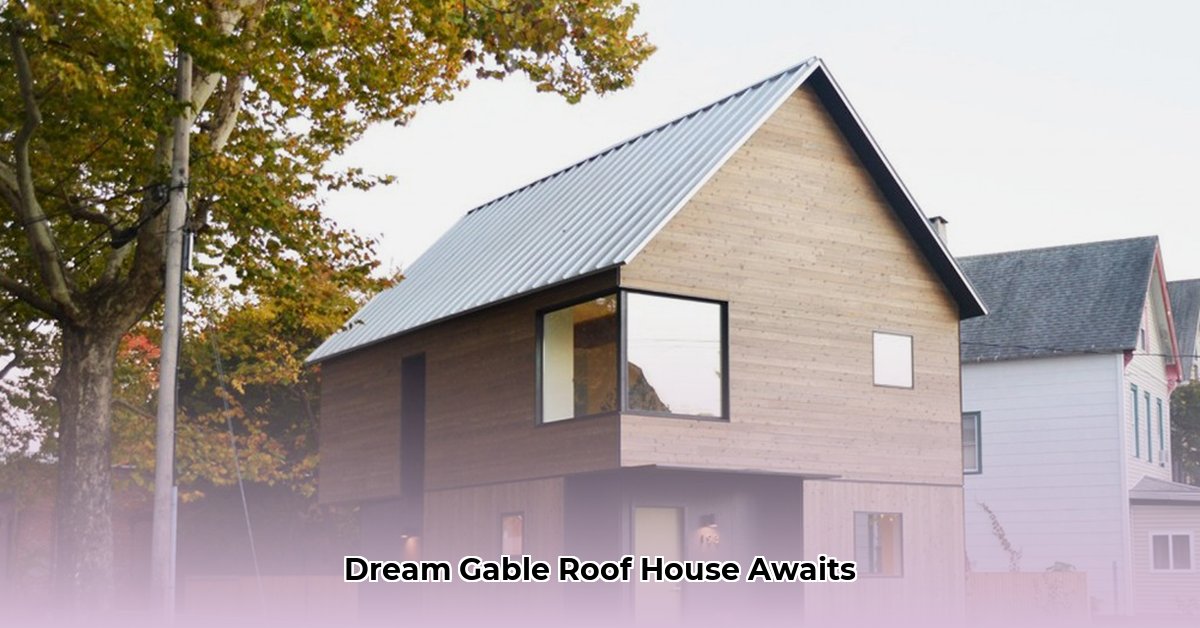Thinking about building or renovating a house and love that classic, pitched roof look but want something modern? This guide is for you! We’ll explore different styles of modern gable roofs – those iconic two-sloped roofs – showing you how to pick the perfect one for your home and what materials work best. We’ll walk you through the design process step-by-step, so you can feel confident making decisions about your roof, from choosing the right slope to picking the best materials for your budget and style. Plus, we’ll share tips for making your roof last and keeping it looking great, saving you money in the long run. For more modern roof design inspiration, check out this great resource: Modern Roof Designs.
Diving into Modern Gable Roof Designs
Let’s talk about gable roofs – those classic, sloping roofs that have graced homes for centuries. But we’re not talking about your grandma’s house here; we’re diving into the world of modern gable roof house design, where traditional charm meets cutting-edge style. Think sleek lines, innovative materials, and a design that’s as functional as it is beautiful. It’s about creating a home that truly reflects your personal style and enhances curb appeal. A well-executed gable roof can dramatically elevate a home’s aesthetic, blending seamlessly with both contemporary and traditional architectural themes.
Exploring Gable Roof Variations for Architectural Interest
The beauty of a modern gable roof lies in its versatility. While a basic, symmetrical gable exudes timeless elegance, modern designs often break the mold. Imagine an asymmetrical gable, creating a dynamic, eye-catching silhouette. Consider a broken gable, where the roofline is cleverly interrupted, adding a touch of architectural intrigue. For larger homes, a multi-gable roof can be incredibly impressive, offering a complex and visually interesting design. A Dutch gable, with its clipped ends and added dormers, provides both visual interest and additional attic space. The options are practically endless, letting you craft a unique look that’s all your own. Don’t be afraid to experiment with different angles and heights to achieve a truly personalized design.
Roofing Material Selection for Longevity and Style
The roofing material you select significantly impacts both the look and lifespan of your home. Metal roofing, for instance, offers incredible durability, energy efficiency, and a sleek, contemporary aesthetic. Available in various colors and finishes, metal roofs are incredibly low-maintenance, meaning you’ll spend less time on repairs and more time enjoying your beautiful home; metal roofs can last 40-70 years, or even longer with proper care. However, it tends to be pricier than other options. On the other hand, natural cedar shingles bring a rustic warmth and charm that’s hard to beat. Their natural beauty adds tons of character, but they do need more regular maintenance compared to metal. Composite shingles offer a balance between cost, durability, and aesthetics, mimicking the look of slate or wood without the associated maintenance. Think carefully about your priorities – a low-maintenance solution versus a more natural, character-filled look. Weigh the pros and cons of each before you decide. Consider factors like fire resistance, wind resistance, and the material’s environmental impact.
Features to Compliment Your Gable Roof: Integrated Design
A truly stunning modern gable roof design goes beyond just the roof itself. Consider eco-friendly additions like solar panels, seamlessly integrated into the roofline for a stylish and sustainable upgrade, improving the home’s energy efficiency and potentially lowering your energy bills. Skylights can dramatically brighten your interior, creating a spacious and airy feel, while also providing passive solar heating in the winter. Carefully planned overhangs offer protection from the elements, shielding windows and walls from rain and sun damage, while adding visual interest and architectural depth. Integrated gutters and downspouts can be designed to blend seamlessly with the roofline, maintaining a clean and modern aesthetic. These additions aren’t just functional; they elevate the overall design, creating a cohesive and impressive look. Consider adding a cupola for ventilation and a touch of traditional charm, or incorporate a green roof section for added insulation and environmental benefits.
Your Step-by-Step Guide to Gable Roof Construction
Building your dream home with a modern gable roof requires careful planning. Here’s a practical step-by-step approach:
- Dream Big (and Talk to a Pro): Begin by sketching out your vision – what style are you aiming for? Minimalist? Rustic? Contemporary? Gather inspiration from magazines, websites, and architectural showcases. Chat with an architect or experienced designer to refine your initial ideas and ensure feasibility. They can offer insights into local building codes and materials that might work best for your climate, as well as provide valuable design expertise.
- Material Selection: The Balancing Act: Consider your budget, the climate, and the overall aesthetic you’re aiming for when choosing your roofing materials. Research the R-value (insulation) and fire resistance rating of different materials. Remember to factor in long-term maintenance costs. Weighing all of these factors will help you make an informed choice. Get samples of different materials and see how they look in different lighting conditions.
- Design Refinement: Getting Specific: Finalize the roof’s pitch (the steepness of the slope), overhangs, and any special features like skylights or solar panels. Consider the placement and orientation of your home to maximize solar gain and natural light. Pay attention to detail – these small choices can dramatically impact the overall effect.
- Blueprint Perfection: Bringing it to Life: Your architect will create detailed blueprints, specifying materials and construction details. Ensure the blueprints include detailed drawings of the roof structure, ventilation system, and flashing details. The more precise the blueprints, the smoother your construction process will be.
- Contractor Quest: Finding the Right Fit: Find a reputable contractor with experience in modern gable roof designs. Ask for portfolios of their previous work and check online reviews. Check references, get multiple quotes, and ensure they have the necessary licenses and insurance.
- Construction Oversight: Your Duty of Care: Keep a close eye on the construction process, making sure the work adheres to the blueprints and all safety standards are met. Conduct regular site visits and communicate any concerns to your contractor promptly. Regular communication with your contractor is key to ensuring a successful project.
Assess the Pros and Cons of Gable Roofs
Let’s be realistic; every design choice has its advantages and drawbacks. Here’s a balanced look at modern gable roofs:
| Feature | Pros | Cons |
|---|---|---|
| Aesthetics | Incredibly versatile, adaptable to various architectural styles. | Can appear simple or dated if not carefully designed. |
| Functionality | Efficient water runoff, structurally sound. | Can be more complex (and potentially more expensive) to build. |
| Maintenance | Varies widely based on the roofing material chosen. | Some materials require more upkeep than others. |
| Cost | Cost is variable and depends heavily on material choices and complexity. | Potentially higher initial cost compared to simpler roof types. |
| Space | Provides ample attic space for storage or living. | Can reduce natural light if not designed with windows or skylights. |
Planning Considerations for Your New Roof
Before you even think about breaking ground, familiarize yourself with local building codes and zoning regulations. Research any height restrictions or specific roofing material requirements in your area. Check with your local authorities early in the design phase to avoid costly delays or changes later on. Think about energy efficiency. Proper insulation and careful material selection can significantly lower your energy bills and reduce your environmental impact. Consider using reflective roofing materials to reduce heat absorption in warmer climates. These choices often pay for themselves in the long run. Remember, your modern gable roof isn’t just about aesthetics; it’s about creating a comfortable, energy-efficient, and beautiful home that reflects your style and priorities. Your final design will showcase the perfect blend of form and function.
Best Gable Roof Material Selection Guide
Key Takeaways:
- Gable roofs, despite their simple design, offer a surprising range of styles impacting cost, durability, and aesthetics.
- Your climate, home size, architectural style, and budget heavily influence material selection.
- Choosing the right material ensures a long-lasting, attractive roof.
- Proper installation is crucial for any roof’s lifespan.
- Consider the long-term maintenance requirements of each material.
Gable Roof Styles and Their Impact on Material Choice
Before diving into materials, let’s explore the diverse world of gable roofs. Think of them as canvases for your home’s personality. A simple gable is clean and classic at a lower material cost. A cross gable adds complexity and visual interest and therefore might need more advanced material. Dutch gables offer charming dormers, while gambrel and saltbox styles bring unique character. Each style affects the roof’s complexity, material needs, and overall cost. A steeper pitch might require materials that can handle faster water runoff, while a shallower pitch may limit your material choices. Which style best complements your modern home vision?
Aesthetics and Functional Material Considerations
Now, how to choose the best gable roof material for my modern home design? This is where aesthetics meet practicality. Let’s explore some popular options:
- Asphalt Shingles: The workhorse of roofing. Affordable and readily available, asphalt shingles offer a range of colors and styles to suit modern designs. Architectural shingles, also known as dimensional shingles, offer a more textured and visually appealing option compared to traditional three-tab shingles. However, they don’t boast the longest lifespan.
- Glass Tile Shower Ideas to Create a Stunning Bathroom Space - December 7, 2025
- Glass Wall Tile Ideas for Kitchens and Bathrooms - December 6, 2025
- Glass Tile Bathroom: Create a Beautiful, Easy-Clean Space - December 5, 2025










